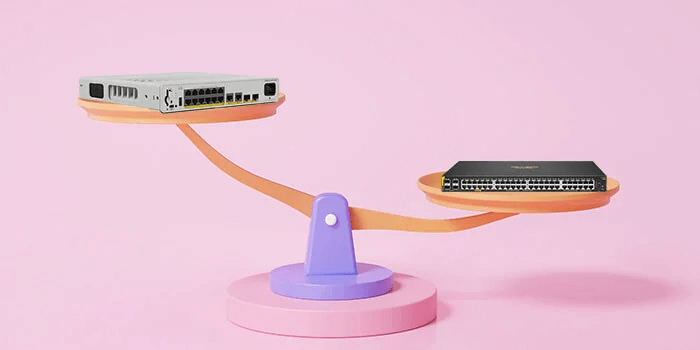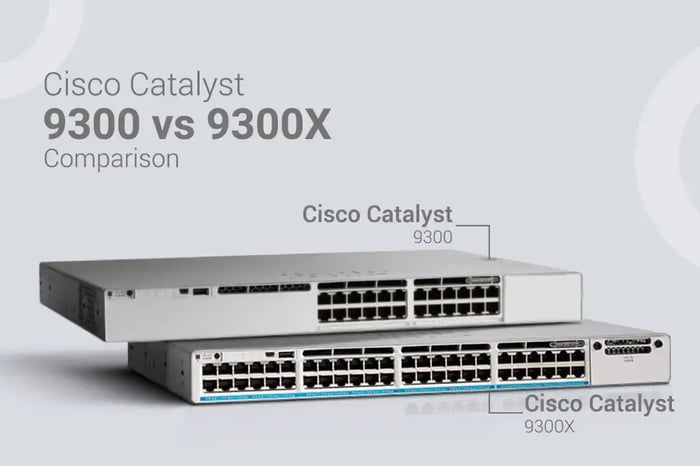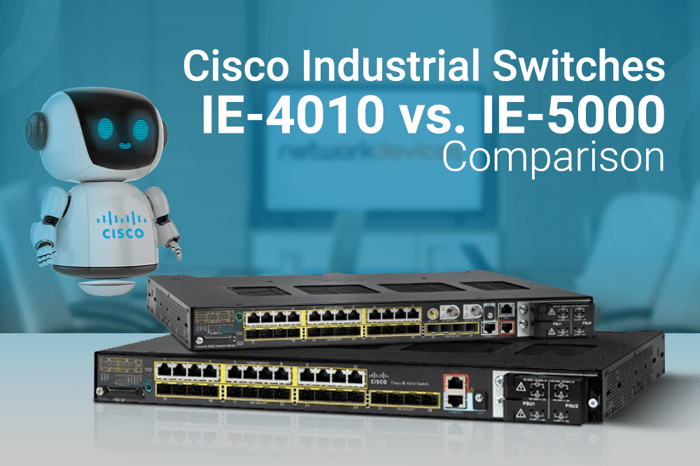You have no items in your shopping cart.

Aruba CX 6000 vs. Cisco 9200 Switches
Businesses can explore the remarkable capabilities of two leading network switches, the Aruba CX 6000 and the Cisco 9200. These switches have gained a reputation for delivering top-notch performance, advanced features, and seamless connectivity, making them essential for modern networking infrastructure. Aruba CX 6000 and Cisco 9200 switches are ideal for SMBs by meeting the demands of today's complex and distributed networks.
In a nutshell, The Aruba CX 6000 series impresses with its built-in analytics and machine learning capabilities, providing:
- Intelligent automation
- Simplified network operations and troubleshooting
On the other hand, the Cisco 9200 boasts a powerful and versatile platform. It enables network administrators to leverage:
- Its extensive security features
- Application optimization
- Multi-gigabit performance
Power Meets Performance
The phrase "Power Meets Performance" signifies the combination of robust capabilities and reliable performance offered by both switches. It highlights that these switches are packed with advanced features and functionalities. They also deliver exceptional performance to meet the demanding requirements of modern networking environments.

Aruba CX 6000 vs. Cisco 9200: Both switches are powerful appliances that can handle the complexities of today's advanced networks. They are equipped with high-performance hardware components and cutting-edge software technologies. These technologies enable them to manage large amounts of data traffic, support high-speed connectivity, and provide reliable network services.
These switches provide more than just raw power. Therefore, Cisco and Aruba emphasize these switches' impressive performance in speed, low latency, and overall network responsiveness. These switches are designed to optimize network performance, ensuring smooth and efficient data transmission, reduced network congestion, and improved user experience.
Aruba CX 6000 Switches
The Aruba 6000 network switches are entry-level access layer switches. They are flexible yet secure solutions for enterprises and mid-sized businesses looking for switches for HQ and branch offices. These switches are what Aruba calls an ASIC architecture and are built on ASIC architecture. (Here are a few examples of products from this family: R8N85A, R8N87A and R8N88A)
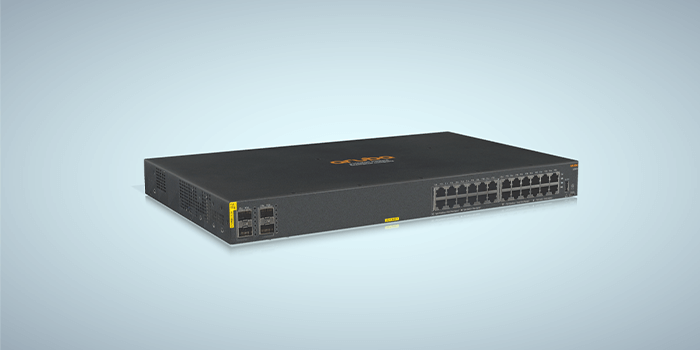
ASIC architecture provides a programmable AOS-CX operating system, the latest database-driven system built on a modular Linux architecture. It is a micro-services architecture that enables full integration with other systems and services. All the software processes communicate with the database rather than each other, which ensures near real-time state and resiliency. These switches are ideal switching appliances for small branch offices, SMB networks, and LAN connectivity.
Aruba CX 6000 Series Switches
Key Features
- Industry's first ASICs Programmable Innovation.
- Ideal for enterprise businesses, ISPs, education, healthcare, government, and financial institutions.
- Supports access control list, advanced Quality of Service, and static routing
- Built-in 1GbE uplink ports and up to 370W of Class 4 PoE to support IoT appliances, IP cameras, and IP phones
- Compact and fanless design.
- Available in 12, 24, and 48 port models.
- Centralized Management with Aruba Central
- Can be managed through Web UI, CLI, and Aruba NetEdit
- Simplified deployment with Zero Touch Provisioning
- Supports REST APIs
- Up to 104 Gbps switching capacity in non-blocking bandwidth
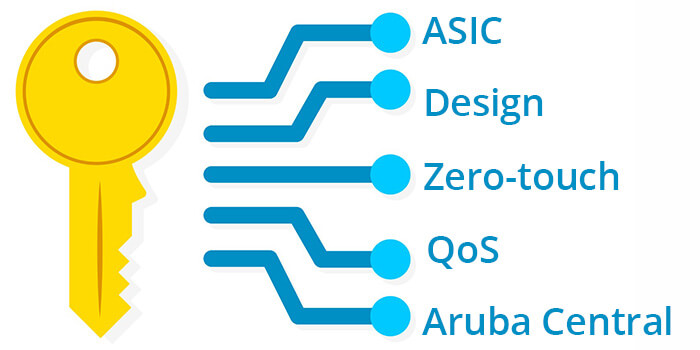
Pros
● Plug-and-play
● Easy to operate
● Reliable
● Secure
● Scalable
● Cost-Efficient
● Manageable
● Best entry-level access switching
Cisco 9200 Switch Series
The Cisco 9200 series provides versatile characteristics that suit both enterprise and small businesses and comes with Cisco DNA integration. Cisco DNA offers smart management and automation to meet today's diverse IOT needs to run and operate in L2/L3 with 48 PoE+ interface options alongside support for routing protocols like OSPF, RIP, ISIS, EIGRP, routed access, and SD-Access. Cisco ISE can also manage these stackable, redundant power supply switches.
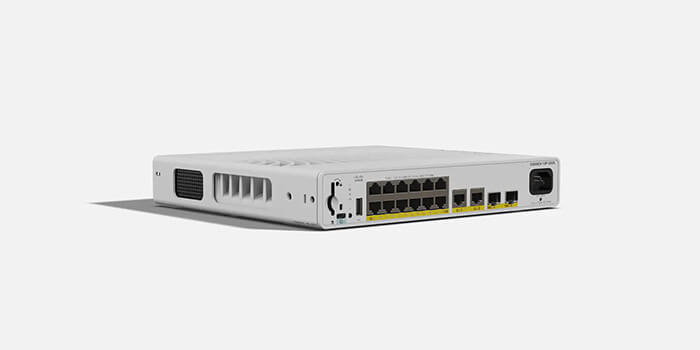
It offers versatile characteristics that suit both enterprises and small businesses, such as:
- Meeting the need for core, access, or distribution layer switches
- Operating and supporting business continuity, data transfer, and better performance
The 9200 series is a top choice due to its wide range of interface options and enhanced security. These features eliminate the need and limitations of its siblings. (Here are a few examples of products from this family: Cisco Catalyst C9200L-48P-4G-A, Cisco Catalyst C9200-24P-E and Cisco Catalyst C9200L-24T-4X-E)
Cisco Catalyst 9200 Series Switches
Key Features
● Smart management with Cisco DNA
● L2/L3 routing
● PoE
● Stacking
● 48 Ports PoE+
● FRU-Redundant power supply
● UADP 2.0 mini, along with an integrated CPU, offers an optimized cost structure
● Support for routing protocols OSPF, RIP, ISIS, EIGRP, and routed access
● SD-Access
● Can be managed through Cisco ISE
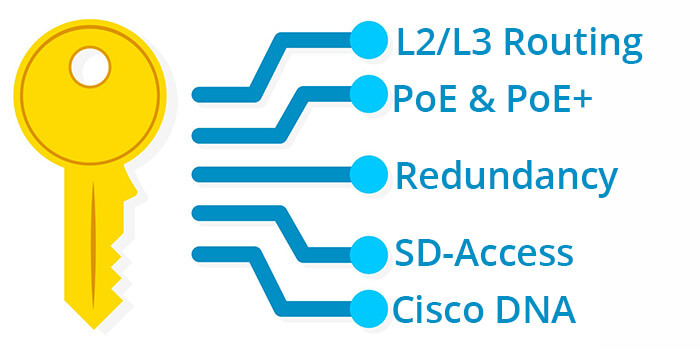
Pros
● Secure and faster data transmission
● Powered by Cisco DNA for network automation and smooth onboarding
● Options for different licensing modules
● Options for 24 and 48 ethernet ports
● Rich set of CLI commands
● Attractive GUI
● Support for additional SPF module
Cons
● Not suitable for large networks
● Requires training to operate.
● Requires an additional license for advanced features
Powerful Performance with Enhanced Security
Both Aruba switches offer robust performance capabilities while prioritizing advanced security features. These switches can handle significant data throughput and provide efficient network operations. Aruba CX 6000 vs. Cisco 9200 switches are designed to deliver fast and reliable network connectivity, allowing for smooth data transmission and efficient network management.

Both switches emphasize enhanced security features to protect the network infrastructure and data. This includes advanced security protocols, encryption mechanisms, and authentication methods to ensure data integrity and prevent unauthorized access to the network.
These switches have a dual purpose. They aim to protect sensitive information and defend against potential threats. At the same time, they will not interfere with the network operations and performance. Below are the few security features offered by these switches.
1. Access Control: The switches offer robust access control mechanisms to authenticate and authorize users or devices before granting them network access. This helps prevent unauthorized access and ensures only legitimate users or devices can connect to the network.
2. Network Segmentation: Both switches support network segmentation, which divides the network into smaller, isolated segments. This helps contain potential security breaches by separating critical resources and limiting the spread of any security incidents.
3. Secure Management Interfaces: The switches provide secure management interfaces, such as secure shell (SSH) or HTTPS, for administrators to access and configure the switches. Encrypting management traffic ensures confidentiality and protects against unauthorized access to sensitive configuration settings.
4. Security Monitoring and Logging: Both switches likely offer security monitoring and logging capabilities, allowing administrators to track and analyze network events, detect security incidents, and facilitate forensic analysis if necessary. This helps in identifying and resolving security issues promptly.
5. Layer 2 Security: Implementing layer 2 security on a network switch helps safeguard network communications, prevent unauthorized access, protect against network disruptions, and ensure the integrity and confidentiality of transmitted data. Aruba CX 6000 vs. Cisco 9200: Both offer layer 2 or switching security in the form of encryption, STP and BPDU guard, IGMP, DHCP Snooping, and STP root guard.
Technical Feature Comparison
| SN | Features | Aruba 6000 48G | Cisco 9200-48P |
| 1 | Maximum Switching Capacity | 104 GBPS | 176 GBPS |
| 2 | Spanning Tree Protocol | Yes | Yes |
| 3 | Port grouping/link aggregation (LACP | Yes | Yes |
| 4 | VLAN | 4096 | 4,094 |
| 5 | MAC Table | 8,192 | 32,000 |
| 6 | IPV4 Routing | Yes | Yes |
| 7 | IPV6 Support | Yes | Yes |
| 8 | IPV6 Routing | Yes | Yes |
| 9 | DHCP Server | Yes | No |
| 10 | PoE | Yes | Yes |
| 11 | Firmware Upgrade | Yes | Yes |
| 12 | SNMP | Yes | Yes |
| 13 | ACLs | 256 | 1600 |
| 14 | QoS | Yes | Yes |
| 15 | Port-Security | Yes | Yes |
| 16 | Radius/TACACS+ | Yes | Yes |
| 17 | SSL, SSH, STP BPDU, Guard, STP Root Guard, IGMP, DHCP Snooping. | Yes | Yes |
| 18 | USB Slot | Yes | Yes |
| 19 | Console Port | Yes | Yes |
| 20 | Flash | 16 GB eMMC | 4 GB |
| 21 | DRAM | 4 GB DDR3 | 4 GB |
How Does Aruba CX 6000 Stand Out with Alternate Cisco Switches?
In the world of Cisco, Aruba is making a positive impact with its diverse portfolio of networking solutions. Aruba's AOS (Aruba Operating System) is a comprehensive operating system facilitating seamless connectivity across the entire range of Aruba devices. AOS excels in scalability, automation, extensible APIs, and enforcing network policies.
Aruba's cloud-powered unified management system simplifies network administration, offering centralized control, one-touch deployment, and rapid troubleshooting. It ensures consistent performance during updates, implements dynamic segmentation for role-based policies, and enhances network security.
The entry-level access layer switches from Aruba are generally more affordable, easy to set up and operate, and offer richer features compared to alternative Cisco switches. Features include cloud-based and on-premise management, simple and automated provisionings, centralized control and monitoring, and more.
Overall, Aruba's solution encompasses a robust operating system, unified management system, and dynamic segmentation capabilities, all aimed at delivering enhanced connectivity, simplified administration, improved security, and efficient network management.







